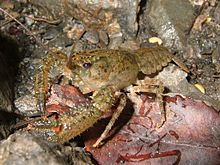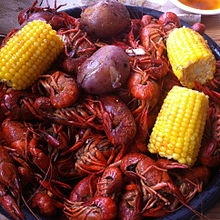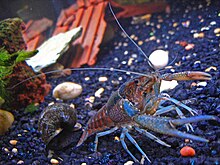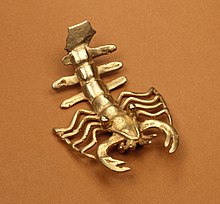Crayfish
| Crayfish Temporal range:
| |
|---|---|

| |
| Northern kōura, Paranephrops planifrons (Parastacidae) | |
| Scientific classification | |
| Domain: | Eukaryota |
| Kingdom: | Animalia |
| Phylum: | Arthropoda |
| Class: | Malacostraca |
| Order: | Decapoda |
| Suborder: | Pleocyemata |
| (unranked): | Reptantia |
| Infraorder: | Astacidea |
Superfamilies and families
| |
| |


Crayfish
The term "crayfish" is applied to saltwater species in some countries.
Terminology
The name "crayfish" comes from the
Some kinds of crayfish are known locally as lobsters,[4] crawdads,[5] mudbugs,[5] and yabbies. In the Eastern United States, "crayfish" is more common in the north, while "crawdad" is heard more in central and southwestern regions, and "crawfish" farther south, although considerable overlaps exist.[6]
The study of crayfish is called astacology.[7]
Anatomy
The body of a
Diet
Crayfish are opportunistic
They have the potential to eat most foods, even nutrient poor material such as grass, leaves, and paper, but can be highly selective and need variety to balance their diet. The personalities of the individual crayfish can be a key determinant in the food preference behaviour in aquaria.[citation needed]
Crayfish all over the world can be seen in an
They feed on submerged vegetable material at times, but their ability to catch large living animal material is restricted. They can feed on
On a day-to-day basis, they consume what they can acquire in their immediate environment in limited space and time available -
Detritus or mud is a mixture of dead plankton (plant and animal), organic wastes from the water column, and debris derived from the aquatic and terrestrial environments. Mostly detritus is in the end phase of decomposition and is recognised as black organic mud. The crayfish usually ingest the material in only a few minutes, as distinct from grazing for many hours. The material is mixed with digestive fluids and sorted by size. The finer particles follow a slower and more exacting route through to the hindgut, compared to the coarser material. The coarser material is eliminated first and often reappears in approximately 10 to 12 hours, whereas the finer material is usually eliminated from 16 to 26 hours after ingestion.[12]
All waste products coming out through the hindgut are wrapped in a
Feeding exposes the crayfish to risk of predation, and so feeding behaviour is often rapid and synchronised with feeding processes that reduce such risks — eat, hide, process and eliminate.
Knowledge of the diet of these creatures was considered too complex since the first book ever written in the field of zoology, The Crayfish by
Classification and geographical distribution
Crayfish are closely related to
| Astacidea |
| ||||||||||||||||||
Four
North America
The greatest diversity of crayfish species is found in southeastern North America, with over 330 species in 15 genera, all in the family Cambaridae. A further genus of astacid crayfish is found in the
In 1983,
Australia
Australia has over 100 species in a dozen genera. It is home to the world's three largest freshwater crayfish:
- the Tasmanian giant freshwater crayfish Astacopsis gouldi, which can achieve a mass over 5 kg (11 lb) and is found in rivers of northern Tasmania[23]
- the Murray-Darling basin.[24]
- the marron from Western Australia (now believed to be two species, Cherax tenuimanus and C. cainii) which may reach 2.2 kg (4.9 lb)
Many of the better-known Australian crayfish are of the genus Cherax, and include the
The marron species C. tenuimanus is
New Zealand
In New Zealand, two species of Paranephrops are endemic, and are known by the Māori name kōura.[26]
Other animals
In Australia, New Zealand, and
In
In the United Kingdom and Ireland, the terms crayfish or crawfish commonly refer to the
Fossil record
Fossil burrows very similar in construction to those of modern crayfish and likely produced by early crayfish are known from the
Threats to crayfish
Crayfish are susceptible to infections such as
Acid rain can cause problems for crayfish across the world. In whole-ecosystem experiments simulating acid rain at the Experimental Lakes Area in Ontario, Canada, crayfish populations crashed – probably because their exoskeletons are weaker in acidified environments.[42]
Invasive pest
In several countries, particularly in Europe, native species of crayfish are under threat by imported species, particularly the signal crayfish (
Uses
Culinary use
Crayfish are eaten worldwide. Like other edible crustaceans, only a small portion of the body of a crayfish is eaten. In most prepared dishes, such as soups, bisques and étouffées, only the tail portion is served. At crawfish boils or other meals where the entire body of the crayfish is presented, other portions, such as the claw meat, may be eaten.[citation needed]
Research shows that crayfish do not die immediately when boiled alive, and respond to pain in a similar way to mammals. Then the stress hormone cortisol is released and this leads to the formation of lactic acid in the muscles, which makes the meat taste sour. Crayfish can be cooked more humanely by first freezing them unconscious for a few hours, then destroying the central nervous system along their abdomen by cutting the crayfish lengthwise with a long knife down the center of the crayfish before cooking it.[45]
Global crayfish production is centered in Asia, primarily China. In 2018, Asian production accounted for 95% of the world's crawfish supply. [46]
Crayfish is part of Swedish cuisine and is usually eaten in August at special crayfish parties (Swedish Kräftskiva). Documentation of the consumption of crayfish dates to at least the 16th century. On the Swedish west coast, Nephrops norvegicus (Swedish Havskräfta, sea crayfish) is more commonly eaten while various freshwater crayfish are consumed in the rest of the country. Prior to the 1960s, crayfish was largely inaccessible to the urban population in Sweden and consumption was largely limited to the upper classes or farmers holding fishing rights in fresh water lakes. With the introduction of import of frozen crayfish the crayfish party is now widely practiced across all spheres in Sweden and among the Swedish-speaking population of Finland.[47]
In the United States, crayfish production is strongly centered in Louisiana, with 93% of crayfish farms located in the state as of 2018.[48] In 1987, Louisiana produced 90% of the crayfish harvested in the world, 70% of which were consumed locally.[49] In 2007, the Louisiana crayfish harvest was about 54,800 tons, almost all of it from aquaculture.[50] About 70–80% of crayfish produced in Louisiana are Procambarus clarkii (red swamp crawfish), with the remaining 20–30% being Procambarus zonangulus (white river crawfish).[51] Optimum dietary nutritional requirement of freshwater crayfish, or crayfish nutrient specifications are now available for aquaculture feed producers [52]
Like all crustaceans, crayfish are not
Bait
Crayfish are preyed upon by a variety of
When using crayfish as bait, it is important to fish in the same environment where they were caught. An
Pets
Crayfish are kept as pets in freshwater aquariums. They prefer foods like shrimp pellets or various vegetables, but will also eat tropical fish food, regular fish food, algae wafers, and small fish that can be captured with their claws. A report by the National Park Service[65] as well as video and anecdotal reports by aquarium owners[66] indicate that crayfish will eat their moulted exoskeleton "to recover the calcium and phosphates contained in it."[65] As omnivores, crayfish will eat almost anything; therefore, they may explore the edibility of aquarium plants in a fish tank. However, most species of dwarf crayfish, such as Cambarellus patzcuarensis, will not destructively dig or eat live aquarium plants.[67]
In some nations, such as the
Sentinel species
The Protivin brewery in the Czech Republic uses crayfish outfitted with sensors to detect any changes in their bodies or pulse activity in order to monitor the purity of the water used in their product. The creatures are kept in a fish tank that is fed with the same local natural source water used in their brewing. If three or more of the crayfish have changes to their pulses, employees know there is a change in the water and examine the parameters.[69]
Scientists also monitor crayfish in the wild in natural bodies of water to study the levels of pollutants there.[69][70][71]
See also
Notes
- ^ In some locations, they are also known as baybugs, crabfish, craws, crawfish, crawdaddies, crawdads, freshwater lobsters, mountain lobsters, mudbugs, rock lobsters, signal crawfish, or yabbies.
References
- ^ Christoph Needon; Johannes Petermann; Peter Scheffel; Bernd Scheibe (1971). Plants and Animals (Pflanzen und Tiere). Leipzig: Urania Verlag.
- ^ a b c "crayfish". Oxford English Dictionary (Online ed.). Oxford University Press. (Subscription or participating institution membership required.)
- ^ Wedgwood, Hensleigh (1855). "On False Etymologies". Transactions of the Philological Society (6): 65.
- S2CID 86017542.
- ^ a b Pableaux Johnson. "Mudbug Madness : Crawfish". Bayou Dog. Archived from the original on 19 August 2006. Retrieved 28 August 2006.
- ^ Bert Vaux; Scott A. Golder. "Dialect survey". Harvard University. Retrieved 30 September 2006.
- ^ "About the International Association of Astacology". Archived from the original on 5 April 2005.
- ^ "What Is the Difference Between Walking Legs and Chelipeds in Crayfish?". Pets on Mom.com. Retrieved 12 June 2021.
- ^ O'Brien, Brett G. (1990). "Feeding Biology of Marron Cherax tenuimanus Decapoda: Parastacidae". National Symposium of Freshwater Crayfish Culture Proceedings: 89–104.
- ^ a b O'Brien, B.G.; Davies, P.M. (2002). "The structure of marron (Cherax tenuimanus) food webs in commercial ponds: results from multiple stable isotope analyses". Freshwater Crayfish. 13 (1): 155–163.
- ^ O'Brien, Brett G. (1995). "The natural diet of the freshwater crayfish Cherax tenuimanus (Smith 1912) (Decapoda: Parastacidae) as determined by gut content analysis". Freshwater Crayfish. 10 (1): 151-162.
- ^ a b O'Brien, Brett G. (1994). The Feeding Biology of Marron. The University of Western Australia. p. 273.
- PMID 31014217.
- ^ .
- PMID 24562813.
- S2CID 86685246.
- ISBN 978-0-7894-5581-9.
- ^ "What's a Mudbug?" (Press release). Iowa Department of Natural Resources. 12 July 2022.
- ^ "The Crawfish – Louisiana's State Crustacean". American Profile. 11 August 2002. Retrieved 25 November 2017.
- ^ "Crawfish Louisiana State Crustacean". State of Louisiana-Department of Administration. 3 June 2014. Retrieved 25 November 2017.
- ^ "Crawfish Deeply Rooted in Louisiana Culture". Voice of America. 19 April 2016. Retrieved 25 November 2017.
- ISBN 9781604736021. Retrieved 25 November 2017.
- ^ "Tasmanian Giant Freshwater Lobster (Astacopsis gouldi)". Department of the Environment, Water, Heritage and the Arts. 9 February 2007. Retrieved 16 March 2010.
- ^ Fisheries Scientific Committee (2013). "The Murray crayfish – Euastacus armatus as a Vulnerable Species" (PDF). NSW Department of Primary Industries. Archived (PDF) from the original on 1 April 2015. Retrieved 11 March 2019.
- ^ Michael P. Masser; David B. Rouse (1997). "Australian Red Claw Crayfish" (PDF). SRAC Publication (244). Archived from the original (PDF) on 13 May 2005.
- NIWA. 26 May 2009. Retrieved 18 September 2012.
- ^ "Lobsters, rock lobsters and crayfish". Western Australian Museum. Retrieved 30 November 2019.
- JSTOR 20102626.
- ^ "Sweet Chilli Crayfish (龙马精神)". mywoklife.com. 13 February 2010.
- ^ "FAR OCEAN SEA PRODUCTS (PRIVATE) LIMITED". dollarvietnam.com.
- ISBN 978-9812613356.
- .
- ^ "European spiny lobster (Palinurus elephas)". The Marine Life Information Network. Archived from the original on 7 April 2016. Retrieved 17 October 2021.
- ^ "White-clawed (or Atlantic stream) crayfish (Austropotamobius pallipes) - Special Areas of Conservation". sac.jncc.gov.uk. Retrieved 17 October 2021.
- ^ "White-clawed crayfish | Shropshire Wildlife Trust". www.shropshirewildlifetrust.org.uk. Retrieved 17 October 2021.
- ISSN 0278-0372.
- ISSN 1342-937X.
- ^ "Crayfishes from the Jehol biota". Geodiversitas. 45 (24): 689–719. 2023.
- ISSN 0195-6671.
- ^ a b James R. Lee (5 December 1998). "TED Case Studies Crayfish Plague #478 European Crayfish Dispute". Archived from the original on 10 January 2009. Retrieved 20 January 2008.
- ^ "Nonindigenous Aquatic Species - Pacifastacus leniusculus". Retrieved 6 July 2020.
- ^ "A Canadian Scientist Explains How Acid Rain is Still Making its Mark". IISD Experimental Lakes Area. 16 May 2018. Retrieved 6 July 2020.
- ^ "Invading Europe's waterways: The crayfish occupation". 19 December 2019.
- ^ "Invasive species: Why Britain can't eat its way out of its crayfish problem". 13 October 2020.
- ^ Nyheter, S. V. T.; Alström, Vivvi (12 August 2023). "Forskning visar: Kräftor känner smärta när de kokas levande". SVT Nyheter (in Swedish). Retrieved 12 August 2023.
- ^ "Global Aquaculture Production: Procambarus clarkii, 1990-2018". FAO Fisheries Division. Food And Agriculture Organization of the United Nations. Retrieved 21 March 2021.
- ^ Po Tidhom (2004). "The Crayfish Party". The Swedish Institute. Archived from the original on 4 February 2009. Retrieved 29 January 2006.
- ^ "Table 18. Crustacean Sales by Species: 2018 and 2013" (PDF). 2018 Census of Agriculture. USDA, National Agricultural Statistics Service. Archived (PDF) from the original on 19 December 2019. Retrieved 21 March 2021.
- ^ Larry W. de la Bretonne Jr. & Robert P. Romaire (1990). "Crawfish production: harvesting, marketing and economics" (PDF). SRAC Publication (242). Archived from the original (PDF) on 12 December 2010.
- ^ "1978–2007: Louisiana Summary of Agriculture and Natural Resources" (PDF). Louisiana State University Agricultural Center, Baton Rouge, Louisiana. 2009. Archived from the original (PDF) on 2 April 2012.
- ^ "Differences Between Red Swamp Crawfish and White River Crawfish". The Louisiana State University Agricultural Center. Archived from the original on 18 July 2011. Retrieved 25 February 2009.
- PMID 33177672.
- ^ "Kosher defined". Triangle K. Retrieved 1 December 2010.
- PMID 19563636.
- ^ Web, Animal Diversity (16 September 2002). "Kids' Inquiry of Diverse Species, Orconectes propinquus, northern clearwater crayfish: INFORMATION". BioKIDS. Retrieved 27 July 2018.
- ^ Samsel, Jeff (5 August 2005). "5 Great Catfish Baits". Game & Fish. Archived from the original on 8 November 2021. Retrieved 13 February 2021.
- ^ "Striped Bass Feeding Facts and Information". Bass Fishing Gurus. 4 March 2015. Retrieved 27 July 2018.
- ^ "The Key to Locating Bass, Walleye or Pike". Funny Fishing Tshirts & Fishing Gifts – Fish Face. 25 August 2017. Archived from the original on 27 July 2018. Retrieved 27 July 2018.
- ^ Bean, Richard Alden (6 April 2011). "Crayfish: What Better Spring Bait For Bass?". Game & Fish. Retrieved 27 July 2018.
- ^ "Fox and Des Plaines Rivers Watershed" (PDF). Critical Trends in Illinois Ecosystems. Illinois Department of Natural Resources. 2001. Archived from the original (PDF) on 27 March 2009. Retrieved 10 February 2009.
- ^ Tennessee Aquatic Nuisance Species Task Force (2007). Tennessee Aquatic Nuisance Species Management Plan (PDF). Tennessee Wildlife Resources Agency. Archived (PDF) from the original on 9 September 2008.
- ^ "Hawaii Risk Analyses and Management for Dreissenid Mussels" (PDF). US Fish & Wildlife. 2012. p. 3. Archived (PDF) from the original on 30 October 2014. Retrieved 27 July 2018.
- ^ "zebra mussel (Dreissena polymorpha) – Species Profile". Nonindigenous Aquatic Species. 16 November 2005. Retrieved 27 July 2018.
- ^ J. Thompson; F. Parchaso; A. Alpine; J. Cloern; B. Cole; O. Mace; J. Edmunds; J. Baylosis; S. Luoma; F. Nichols (13 December 2007). "The History and Effects of Exotic Species in San Francisco Bay". United States Geological Survey. Archived from the original on 1 July 2013. Retrieved 10 February 2009.
- ^ a b abebault (May 2013). "Crayfish Facts". Google. Archived from the original on 16 February 2017. Retrieved 27 July 2018.
- ^ "YouTube". YouTube. 12 April 2018. Archived from the original on 30 October 2021. Retrieved 27 July 2018.
- ^ Gerald Pottern. "Mexican dwarf orange crayfish, Cambarellus patzcuarensis". Archived from the original on 28 July 2018. Retrieved 13 October 2010.
- . Retrieved 10 May 2018.
- ^ a b Hanrahan, Mark (27 September 2017). "Crayfish staff help Czech brewery keep its water as pure as can be". Reuters TV. Archived from the original on 25 October 2019. Retrieved 25 October 2019.
- ^ "Clean Water". Missouri Conservationist Magazine. Vol. 69, no. 11. Missouri Department of Conservation. November 2008. Archived from the original on 25 October 2019. Retrieved 25 October 2019.
- PMID 10581118.
O’Brien, B.G. (1994). The natural diet of the freshwater crayfish Cherax tenuimanus (Smith 1912) Decapoda:parastacidae) as determined by gut content analysis. Freshwater Crayfish 10, 151-162.
Further reading
- Christoph Goessmann; Charlotte Hemelrijk; Robert Huber (2000). "The formation and maintenance of crayfish hierarchies: behavioral and self-structuring properties" (PDF). (PDF) from the original on 7 September 2006.
- Thomas Henry Huxley (1880). The Crayfish: an Introduction to the Study of Zoology. New York: D. Appleton & Co.
- Sterling K. Johnson; Nathan K. Johnson (2008). Texas Crawdads. College Station, Texas: Crawdad Club Designs. ISBN 978-0-9801103-0-2.
- Regional European Crayfish Workshop: Future of Native Crayfish in Europe. Knowledge and Management of Aquatic Ecosystems. No. 394–395 (2009).
- Jerry G. Walls (2009). Crawfishes of Louisiana. Baton Rouge, LA: Florida State University Press. ISBN 978-0-8071-3409-2.



